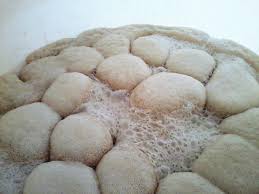Your Cart is Empty
FREE Worldwide Shipping! | +1 365 654 6605
FREE Worldwide Shipping! | +1 365 654 6605
March 31, 2024 4 min read

Yeast and leaven are two terms often used interchangeably when discussing baking and bread-making. However, they are not exactly the same thing. In this article, we will delve into the world of leavening agents, exploring the differences between yeast and leaven, their unique characteristics, and their roles in creating delicious baked goods. So, let's get started!
Leavening agents play a crucial role in baking by lightening the texture of the dough or batter and creating gas bubbles that make the final product rise. They are responsible for the airy and fluffy texture of bread, cakes, and other baked goods. There are different types of leavening agents, including mechanical leavening, chemical leavening, and biological leavening. Mechanical leavening involves incorporating air into the dough or batter during the mixing process. This process can be achieved by techniques like creaming butter and sugar, whipping egg whites or cream, and folding them into the other ingredients. The incorporation of air creates pockets of gas that expand during baking, resulting in a light and fluffy texture. Mechanical leavening is commonly used in recipes like puff pastry and angel food cake. Chemical leavening agents create gas bubbles through a chemical reaction when mixed with the dough or batter. Baking powder and baking soda are examples of chemical leavening agents. These agents react with acidic components in the recipe, such as lemon juice or buttermilk, to produce carbon dioxide gas. The gas bubbles expand during baking, causing the dough or batter to rise. Quick breads, biscuits, and layer cakes are typical examples of baked goods that rely on chemical leavening. Biological leavening agents utilize fermentation to create gas bubbles as they consume sugars or carbohydrates in the batter or dough. The most common biological leavening agents are baker's yeast and sourdough starters. These agents contain wild yeasts and lactobacilli that work together in a symbiotic relationship. The yeasts feed on sugars and produce carbon dioxide gas, while the lactobacilli contribute to the unique flavor profile of sourdough. Bread is a prime example of the biological leavening process, although other fermented products like beer, yogurt, and buttermilk also fall into this category. While yeast is a type of leavening agent, not all leavening agents are yeast. Yeast refers specifically to the group of microorganisms that belong to the Saccharomyces cerevisiae species. These yeasts are commonly used in baking and brewing due to their ability to ferment sugars and produce carbon dioxide gas. However, the yeasts found in sourdough cultures are typically different from the yeast used in commercial baking. Wild yeasts like Candida milleri or Saccharomyces exiguus are often present in sourdough cultures, contributing to the distinct flavor and texture of sourdough bread. Before the discovery of yeast by Antonie van Leeuwenhoek in 1680 and Louis Pasteur's identification of yeast's role in fermentation in 1857, all leavened bread was sourdough. Yeast, as we know it today, is a domesticated form of wild yeasts found in nature. In ancient times, people relied on capturing wild yeasts from the environment to leaven their bread. This was achieved by leaving a mixture of flour and water exposed to the air, allowing the naturally occurring yeasts to colonize the mixture and initiate the fermentation process. Modern bread yeasts are strains of yeast selected for their fast-acting and reliable fermentation properties. These strains have been developed through centuries of selective breeding and genetic modification. Unlike the wild yeasts found in sourdough cultures, modern bread yeasts are typically derived from brewing yeasts. They have been optimized for commercial baking, allowing for consistent and predictable results in a shorter amount of time. While they are efficient leavening agents, modern bread yeasts do not impart the unique flavor and complexity associated with sourdough bread. Sourdough cultures have been passed down through generations in different regions, resulting in unique and prized flavors. Bakers often develop a close relationship with their sourdough cultures, as they contribute to the distinctiveness of their baked goods. The process of capturing a new sourdough culture involves allowing wild yeasts and lactobacilli to colonize a mixture of flour and water, creating a living ecosystem. This culture is then fed and maintained regularly to keep the yeasts and bacteria active and healthy. During the feast of unleavened bread, there is a requirement to remove leaven from the house. This practice dates back to biblical times and is observed by Jewish communities. While it is possible to capture a new sourdough culture from the air, bakers often have unique and prized cultures that they are reluctant to lose. It is speculated that in Jewish communities, the sourdough culture may have been moved to an outside location, kept in a crock for the duration of the feast, and then brought back for use afterward. The historic practice surrounding this requirement would be best explained by someone knowledgeable in Jewish culture. In summary, yeast and leaven are related but not the same thing. Yeast refers specifically to the Saccharomyces cerevisiae species used in baking and brewing, while leaven encompasses various types of leavening agents, including mechanical, chemical, and biological agents. Understanding the differences between these agents is crucial for achieving desired textures and flavors in baked goods. Whether using commercial bread yeasts or cultivating their own sourdough cultures, bakers have the opportunity to explore the diverse world of leavening agents and create delicious bread that satisfies both the palate and the soul.1. Understanding Leavening Agents
1.1 Mechanical Leavening
1.2 Chemical Leavening
1.3 Biological Leavening
2. The Difference Between Yeast and Leaven
3. The History of Leavened Bread
4. Modern Bread Yeasts
5. Preservation and Cultivation of Sourdough Cultures
6. Conclusion
References
Be the first to know about upcoming sales and promos. Get a 10% discount coupon when you subscribe!